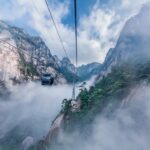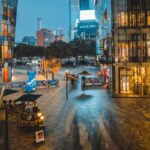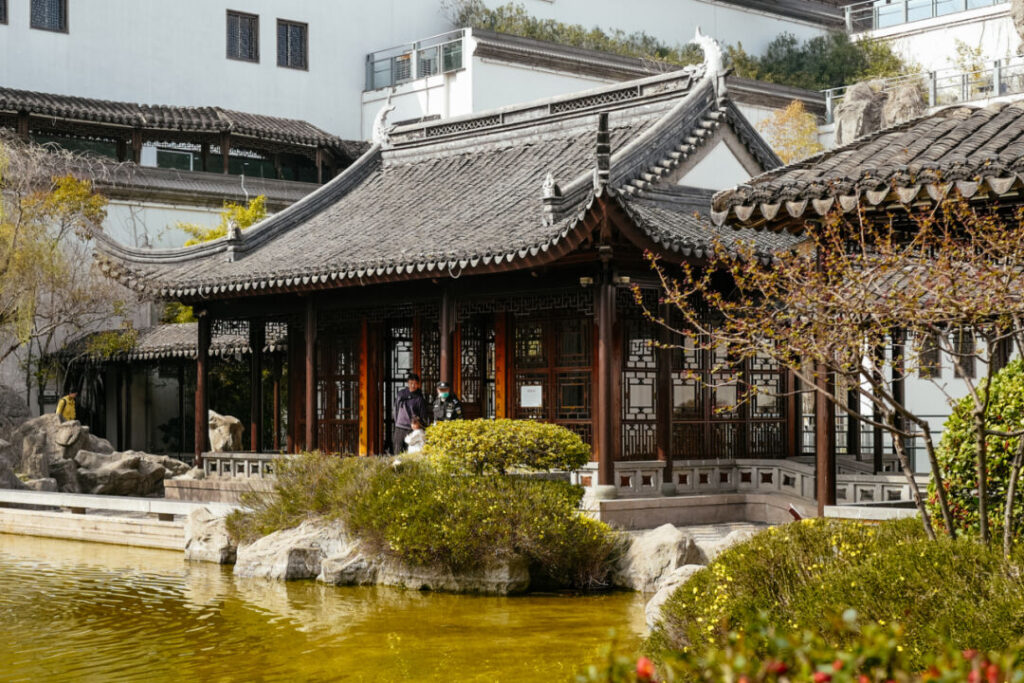
Changjiang Road in Nanjing is often referred to as “one road, half of Nanjing’s history.” At first, I thought this was just an exaggerated rhetorical device. However, after exploring the entire road, I discovered that it was entirely true.

Nanjing is known as the “Ancient Capital of the Six Dynasties.” The remains of the city walls from this period are hidden within the Six Dynasties Museum on this road. During the early Ming Dynasty, when Nanjing became the imperial capital, the Jiangnan Weaving Bureau was established nearby, even though this area was no longer the imperial city.
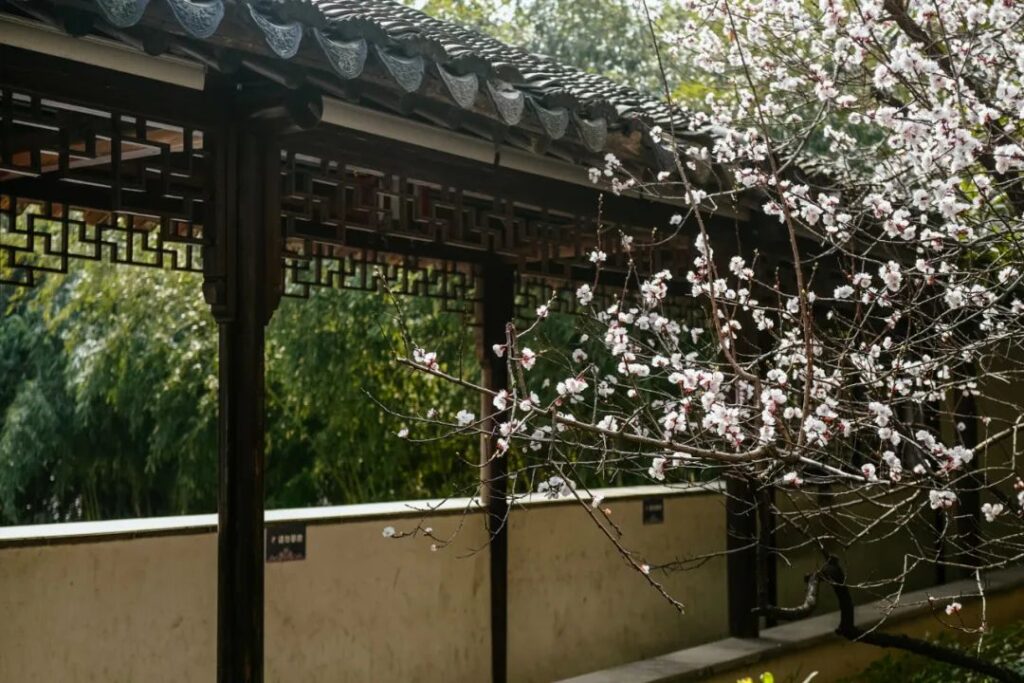
During the Qing Dynasty, this area was not only the location of the Governor-General’s Office of the Two Yangtze Provinces but also the temporary palaces for Emperors Kangxi and Qianlong during their visits to Jiangnan. Even after the Taiping Heavenly Kingdom captured Nanjing, they constructed palaces in this area. In modern times, the presidential palace of the Republic of China was also situated on this road.

Walking along this road, one can see history stacked upon history, making it a dazzling experience. Moreover, with nearby food hotspots like Ke Xiang and the 1912 Block, it’s hard to resist the temptation to explore and eat!
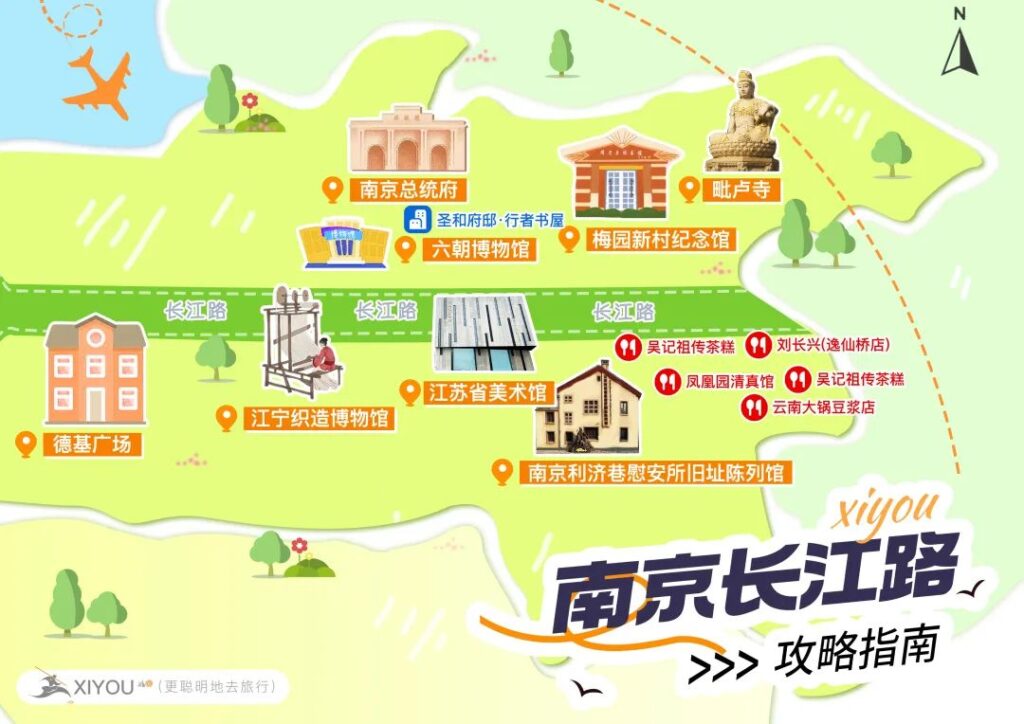
While most historical sites can be somewhat dull, the museums on Changjiang Road offer a refreshing experience with their unique designs and exhibitions.
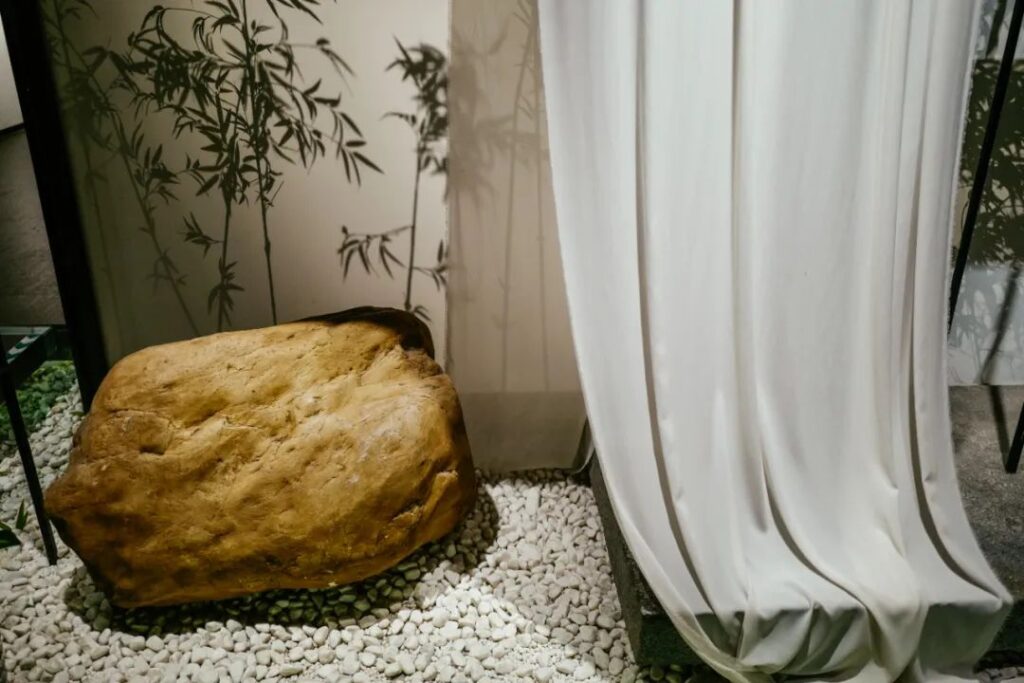
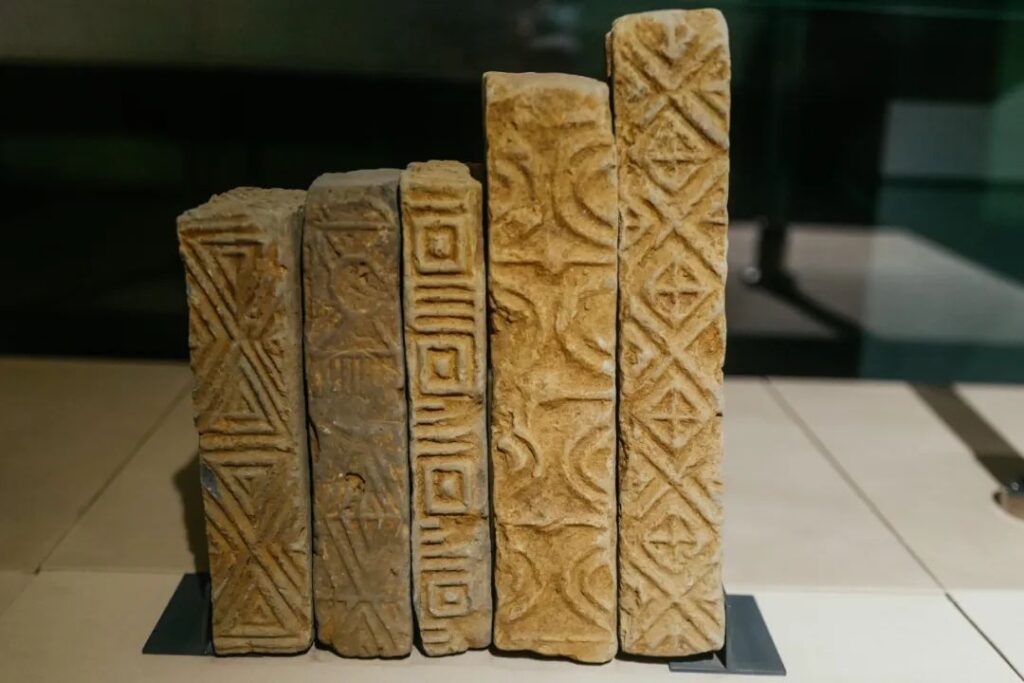
Although I’ve slightly digressed, I’ll now write about the attractions in chronological order. The sites are all located on this street, not far from each other, so you can explore at your own comfortable pace.
Six Dynasties Museum
📍: No. 302 Changjiang Road, Xuanwu District, Nanjing
🕐: 9:00-17:30, last entry at 17:00
🎫: 30 yuan
Before delving into the museum, here’s some stunning background information: the museum was designed by Bei Jianzhong, son of the renowned architect I.M. Pei, and his team. Although I took a slight detour, the main point is that the museum’s exhibitions are full of surprises at every turn.
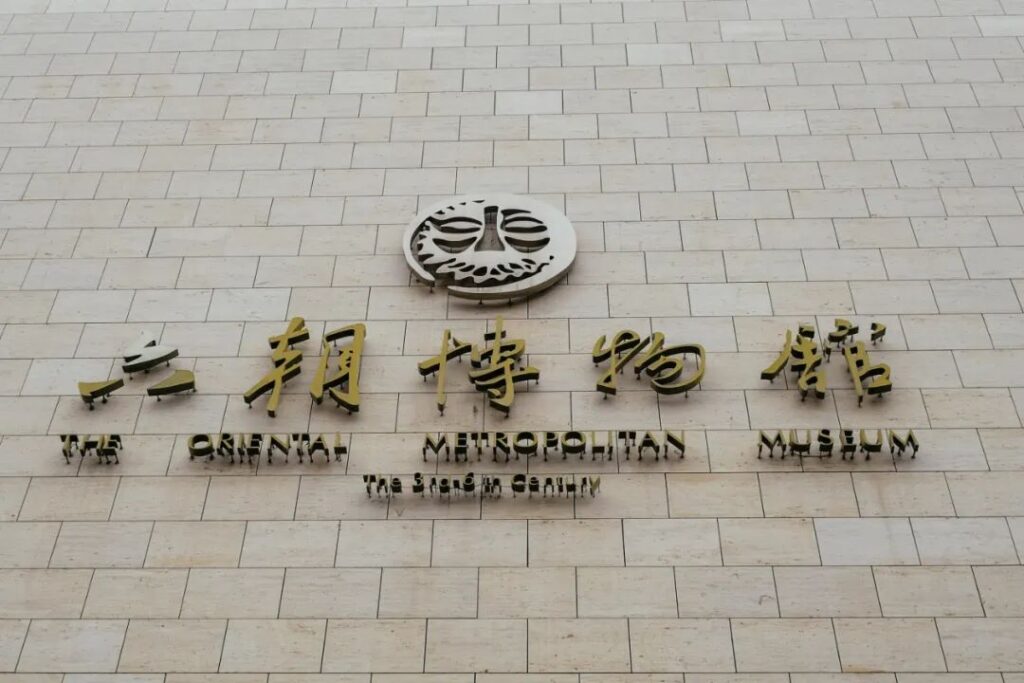
The B1 level, “Capital of the Six Dynasties,” is built directly on the “archaeological site.” The city walls of the ancient capital of the Six Dynasties, excavated in this generation, are presented in their original form.

From the high platform, visitors can see the divisions made according to the archaeological site above the city walls and some details of the wall structure. This maintains a certain distance while allowing visitors to feel engaged.
Artifacts unearthed from the Six Dynasties period, such as tile ends, city bricks, utensils, and bamboo slips, are also displayed nearby.
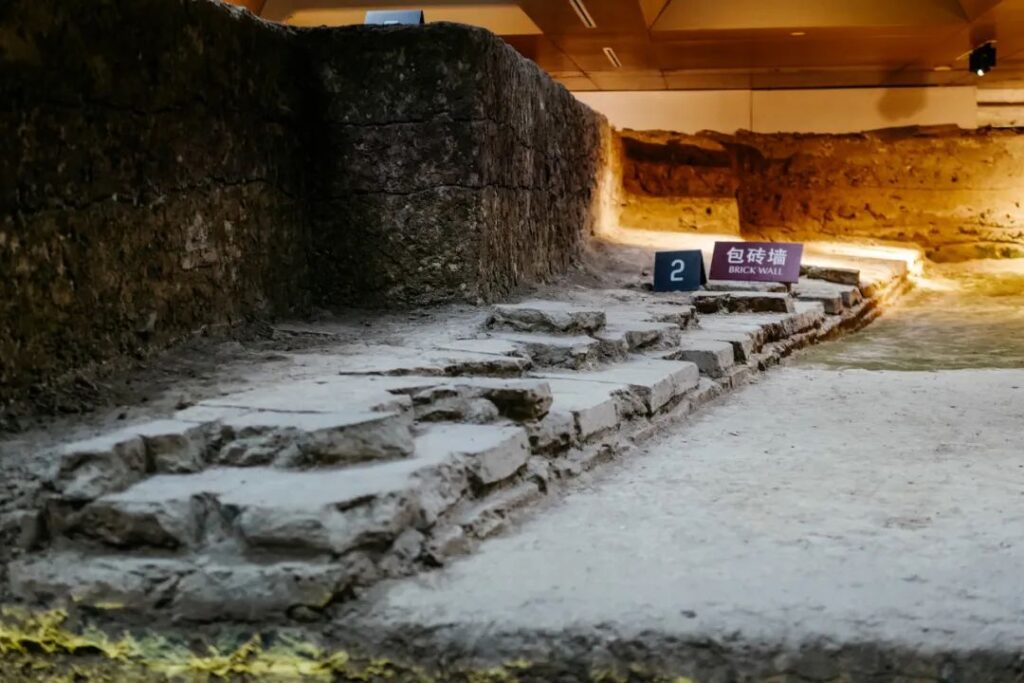
The second floor, “The Splendor of the Six Dynasties,” is my favorite hall. The entire exhibition is filled with the beauty of Chinese-style design. Thin gauze veils the bamboo, creating a natural painting.

A simple screen brings the musical figurines to life.
The use of a circular background introduces light into the hall while also giving the exhibits a sense of being in a garden grotto.
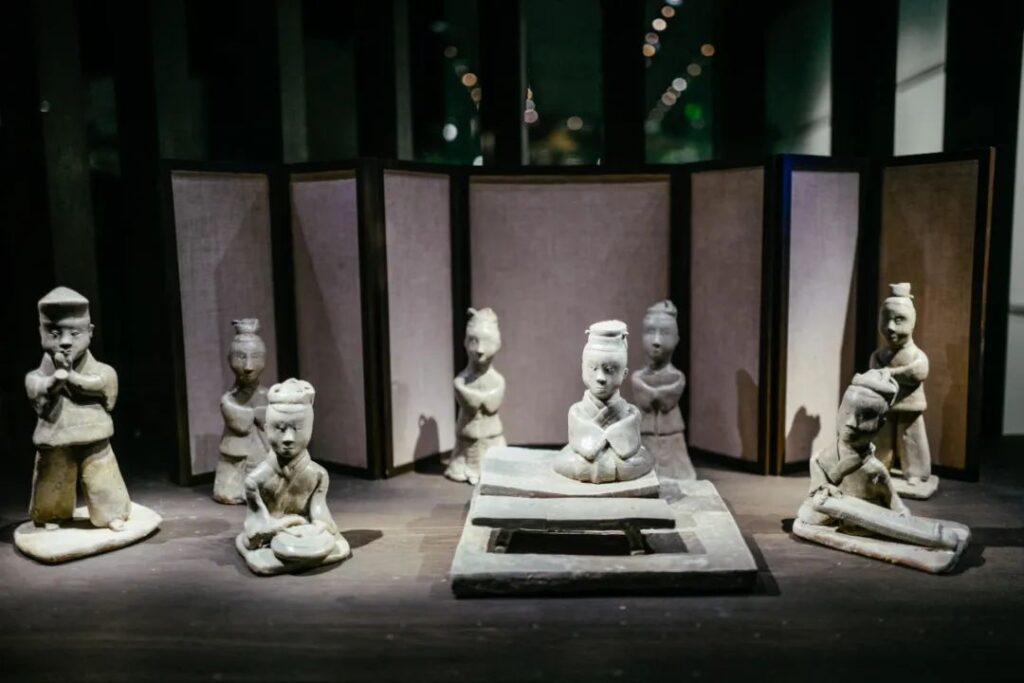
Such ingenious ideas are present throughout the exhibition.
In addition, the misplaced brick paintings of the Seven Sages of the Bamboo Grove, the exquisite celadon lotus zun, and the museum’s treasure, the underglaze painted flared-mouth pot, are all a feast for the eyes.

The top floor, “Figures of the Six Dynasties,” is mainly text-based and slightly more tedious.
However, after exploring the lower floors in detail, the ticket price is well worth it!
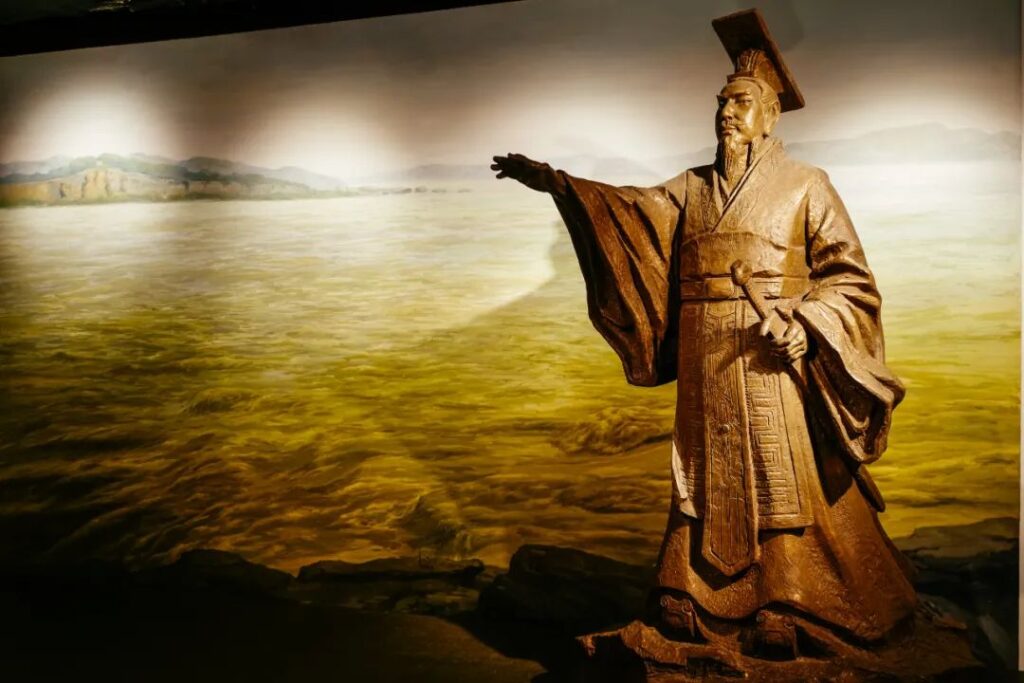
Jiangning Imperial Silk Manufacturing Museum
📍: No. 9 Beiting Lane, Xuanwu District, Nanjing
🕐: 9:00-17:30, last entry at 17:00
🎫: 30 yuan
The designer of the Jiangning Imperial Silk Manufacturing Museum is also a prominent figure – Wu Liangyong, a renowned Chinese architecture and urban planning expert. Of course, the long list of titles before his name might only make people feel impressed but puzzled.
However, when I saw the entrance, I never imagined that this museum would be a garden full of surprises!
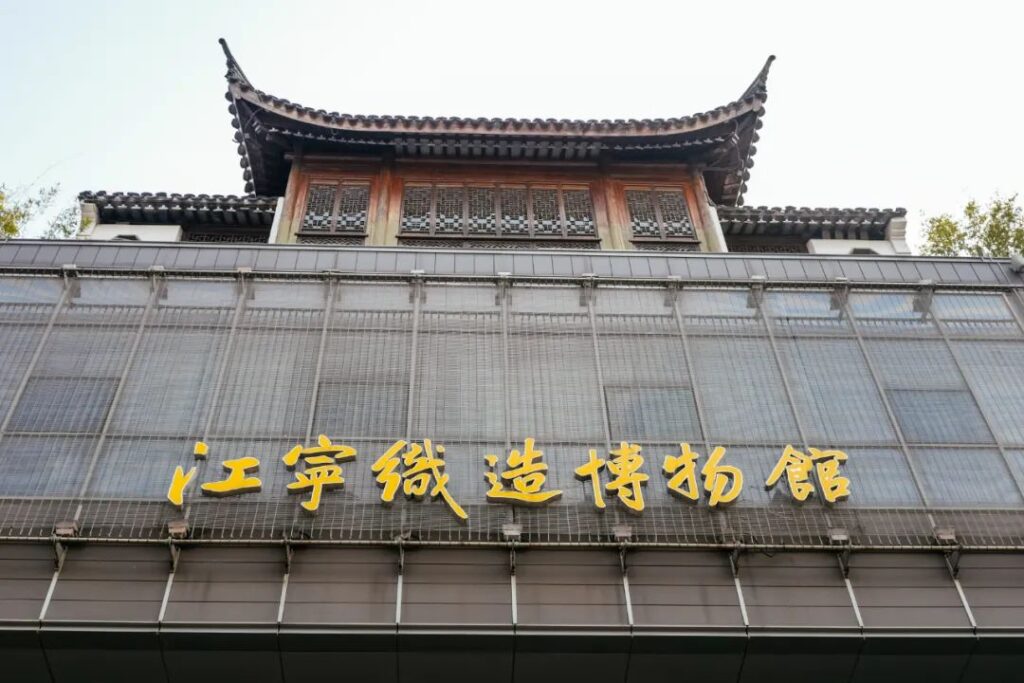
The most impressive aspect of the museum is its distinct layered garden design.
Chinese gardens are primarily focused on the layout, but the museum’s design incorporates Chinese buildings at different levels on the second and third floors, adding a sense of three-dimensionality and freshness.
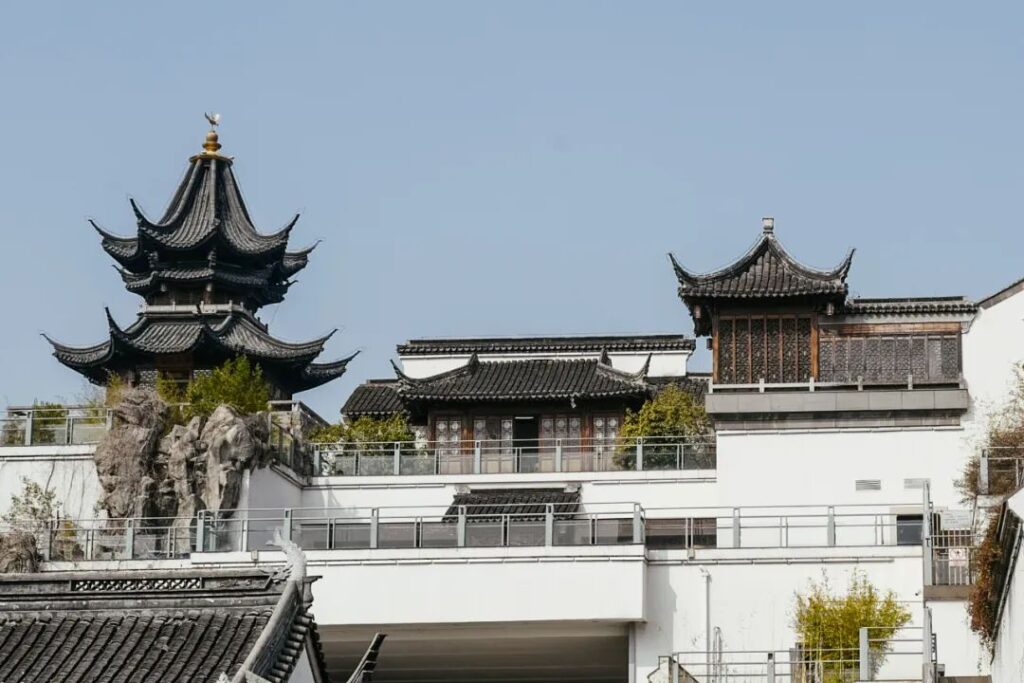
Walking into the garden, the circular to square view frame adds a sense of depth to the appreciation of the scenery in the limited space.
It truly makes people marvel at the clever use of space as they walk through the garden!
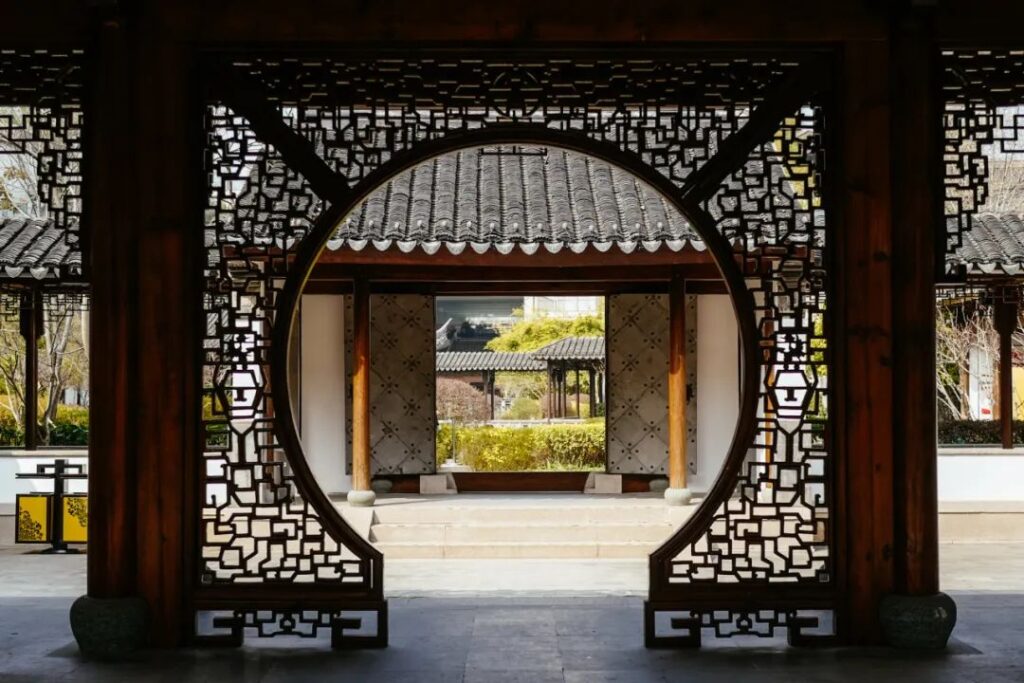
Of course, when visiting a museum, we should return to the main topic~
The exhibitions here have two main threads. One is “Jiangnan Silk Weaving.” The “Yunjin” (brocade) produced here was once exclusively used by the imperial court, representing the pinnacle of Jiangnan silk weaving craftsmanship. The few remaining silk fabrics are also dazzlingly beautiful.

The other thread is “Dream of the Red Chamber.” Three generations and four members of the Cao family served as officials in the Jiangnan Imperial Silk Manufacturing Bureau, and it wasn’t until Cao Xueqin’s generation that the family gradually declined.
As the hometown of Cao Xueqin, the Jiangnan Imperial Silk Manufacturing Bureau was also the source of the luxurious lifestyle described in “Dream of the Red Chamber.”
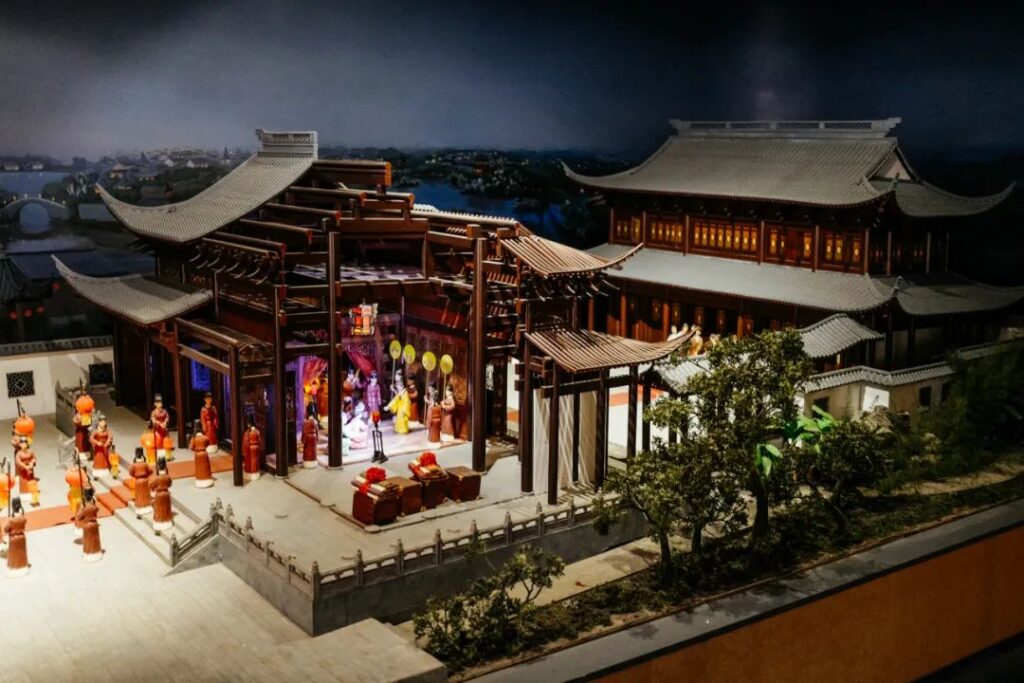
The museum’s exhibition is based on the life story of Cao Xueqin and the classic scenes from “Dream of the Red Chamber.”
I initially just skimmed through this part, but I happened to meet a young woman who was a huge fan of “Dream of the Red Chamber” and had specially come to “pay homage.” From her excited appearance, I suddenly realized the different significance this place holds for fans of the novel~

Pilu Temple
📍: No. 4 Hanfu Street, Xuanwu District, Nanjing
🕐: 9:00-16:30
🎫: 20 yuan
As the starting point of Changjiang Road, the prosperity of Pilu Temple originated from a “playful promise.” During the Tongzhi period of the Qing Dynasty, Zeng Guoquan told the Buddhist monk Haifeng, “If I govern the two Yangtze provinces, I will build a temple for you.” Later, when this became a reality, the war-damaged Pilu Temple on Changjiang Road was rebuilt into the grand and magnificent Pilu Temple.

When the Republic of China established its capital in Nanjing, the temple’s status also rose, becoming the center of Buddhism in the country at that time. The Chinese Buddhist Association and the Chinese Buddhist Research Association were both established here. It can be said to be a temple with a significant background.
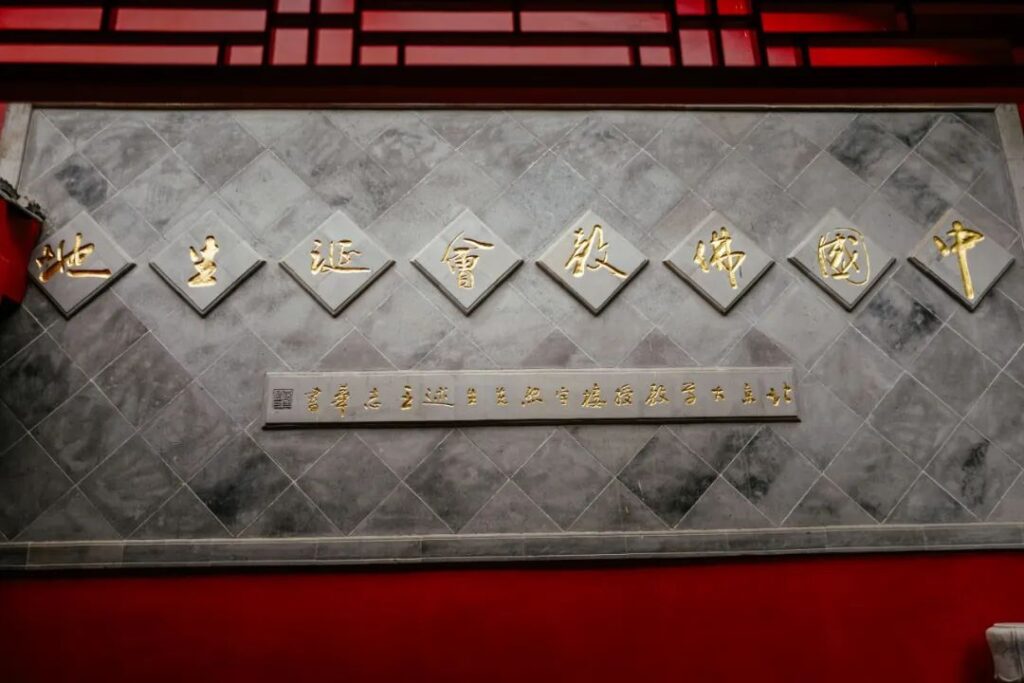
However, compared to the popular Jiming Temple, although located in a bustling area, it is much more tranquil here. What’s special about this temple is that the Mahavira Hall is located right at the entrance. Usually, the Maitreya Buddha, who “welcomes guests,” is placed in a pavilion.
The overall layout utilizes bridges and stairs to add a sense of layering, making it appear solemn yet dynamic.
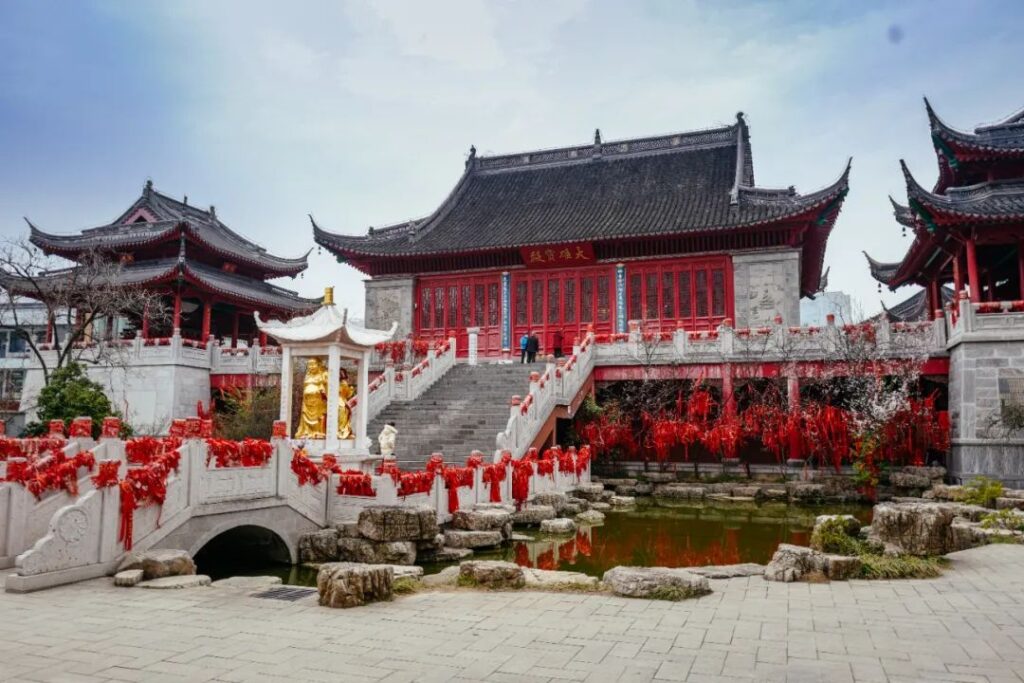
Walking past the Mahavira Hall, you will find the rebuilt Ten Thousand Buddha Tower. Although the “Qianlong Tripitaka” stored in the tower cannot be easily viewed, the gold and iron chime in the Dabao’en Temple’s glazed pagoda and the stone niche of the Huayan Three Saints from the Northern Wei Dynasty are worth seeing.

Nanjing Museum of Modern Chinese History (Presidential Palace)
📍: No. 292 Changjiang Road, Xuanwu District, Nanjing
🕐: 8:30-18:00, last entry at 17:00
🎫: 35 yuan
The Presidential Palace is definitely Nanjing’s “traffic magnet.” I have a lingering fear of my first visit to the Presidential Palace, where I was squeezed to the point of almost suffocating. I had no intention of going again. However, when I passed by, there was only a little over an hour before closing time, and the visible lack of people made me decide to visit again. I unexpectedly gained a leisurely experience at the Presidential Palace with few people and beautiful scenery.
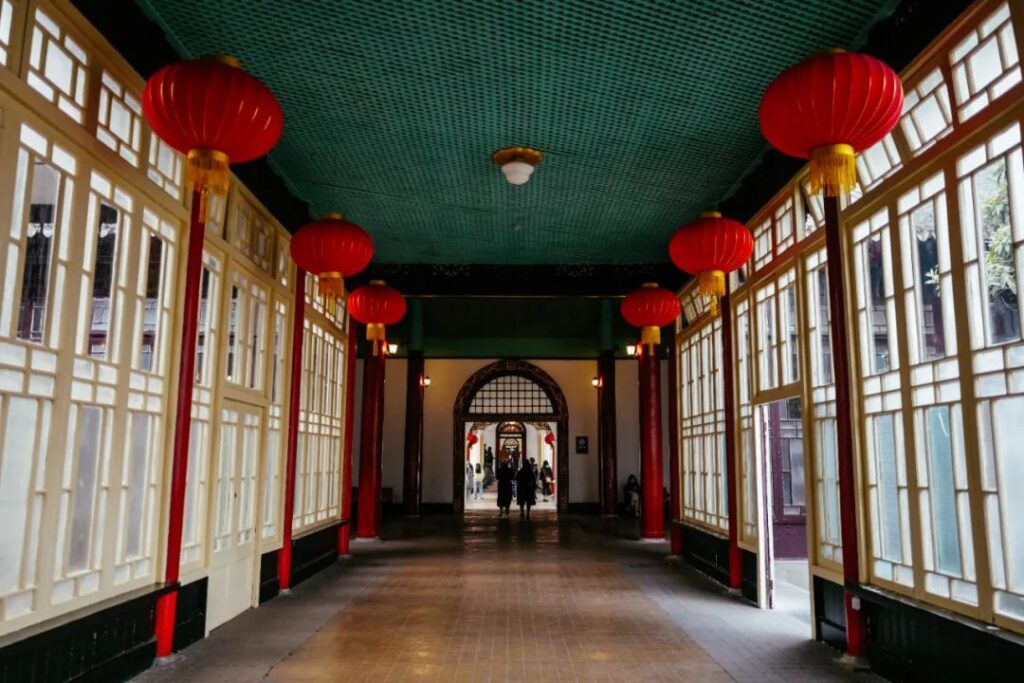
Although famous as the “Presidential Palace,” this place is actually stacked with historical buffs. The earliest can be traced back to the Guidehou Mansion and Hanwang Mansion of the Ming Dynasty; during the Qing Dynasty, it served as the Jiangning Imperial Silk Manufacturing Bureau, the Governor-General’s Office of the Two Yangtze Provinces, and the temporary palace for Emperors Kangxi and Qianlong during their southern tours; later, it became the Heavenly King’s Palace of the Taiping Heavenly Kingdom; and finally, it became the Presidential Palace of the Republic of China.
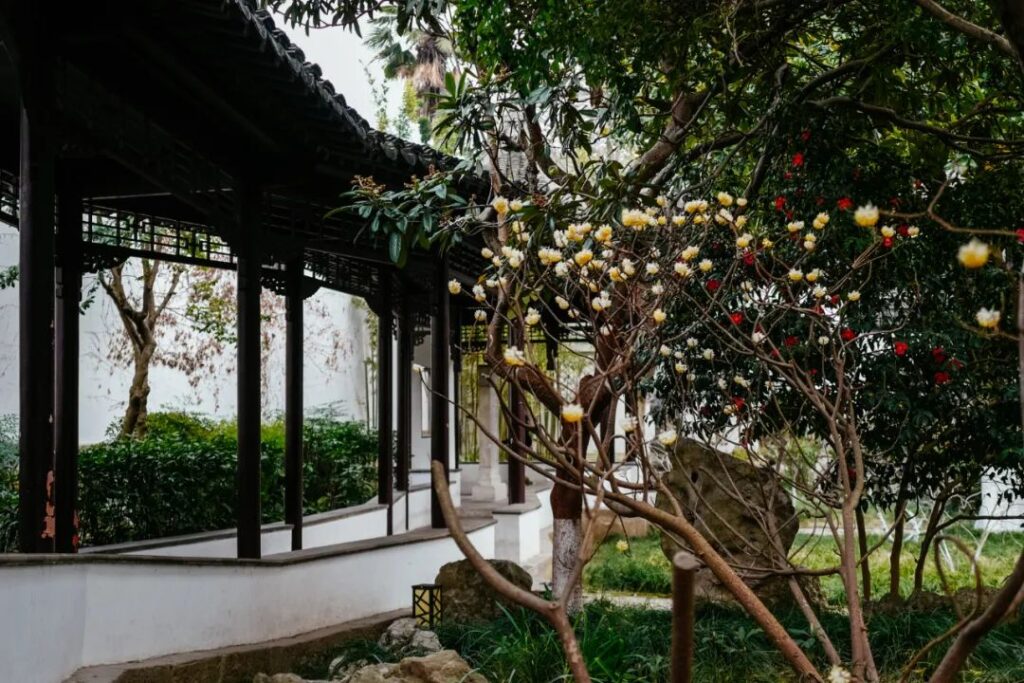
Due to the accumulation of these buffs, passing through a courtyard gate in the Presidential Palace will directly “transport” you to different historical periods.
Walking along the central axis is the authentic “Presidential Palace,” where the history of the Republic of China unfolds. (Although I always feel that the president’s office looks a bit “cramped” and confined)

To the west, Xuyuan is the garden of past dynasties, where the stone boat and Yilan Pavilion still retain the exquisiteness of Jiangnan gardens. When there are few people, it is very comfortable to stroll leisurely.

The eastern line features an exhibition on the history of the Taiping Heavenly Kingdom.
While walking, I recalled Qian Mu’s evaluation. Just by looking at the names they chose, you know this matter cannot succeed. There is always a sense of historical absurdity and unexpectedness.

Although the Presidential Palace is a “must-visit” place in Nanjing, experiencing it with few people and with many people are two completely different experiences. It is recommended to avoid peak hours for the visit. (But I don’t know if there will still be a leisurely time before closing during the peak season)

Chinese Communist Party Delegation Meiyuan New Village Memorial Hall
📍: No. 18-1 Hanfu Street, Xuanwu District, Nanjing
🕐: 9:00-17:30, last entry at 17:00
To be honest, visiting the Meiyuan New Village Memorial Hall feels like being on the set of a “spy war movie.”
During the Kuomintang-Communist negotiations, the Chinese Communist Party delegation led by Premier Zhou Enlai stayed here, engaging in a battle of wits with the personnel responsible for monitoring them next door.

Although the negotiations ultimately broke down, they still influenced the development of the situation at that time.
However, as history is too grand, I actually paid attention to various small details, such as the correspondence between Zhou Enlai and Deng Yingchao.

In a passage about West Lake, Deng Yingchao wrote, “On the lakeside mountains, plum blossoms are in full bloom, red and white intermingled, fragrance wafting in the air, beautiful scenery and pleasant times, making one miss distant loved ones.” After reading it, I was instantly in awe of her writing. With just a few words, she sketched a picture of the spring scenery at West Lake and naturally transitioned to her own feelings of longing.
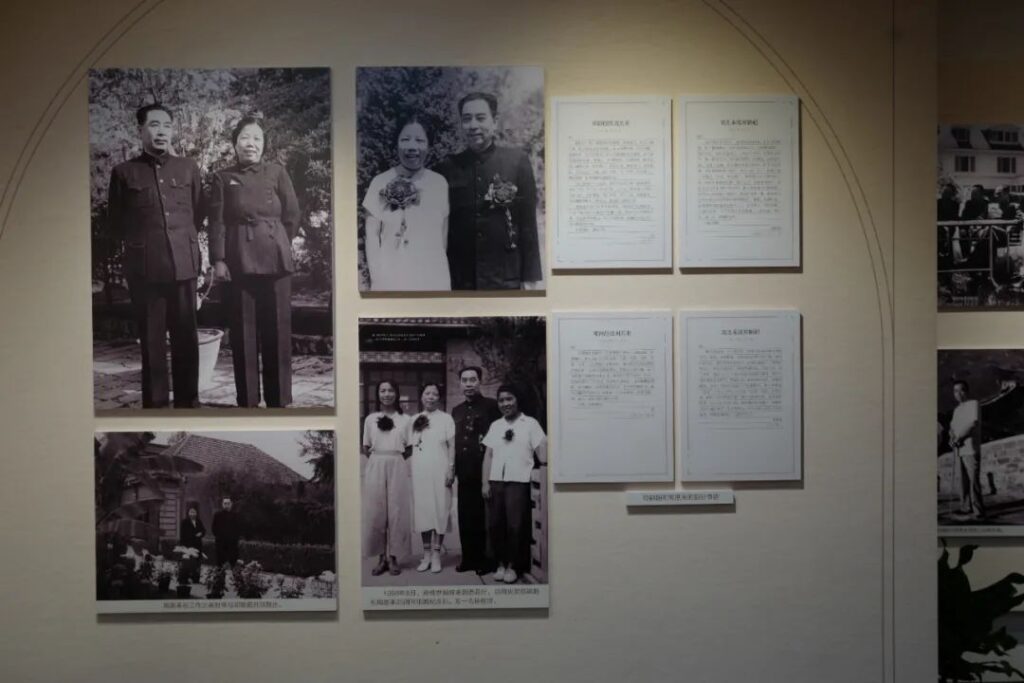
Amidst the torrent of revolution, having such a delicate understanding of nature is truly romantic. I sent it to a friend, who replied, “This couple is really great to obsess over.”

Nanjing Liji Alley Comfort Station Former Site Exhibition Hall
📍: No. 2 Liji Alley, Qinhuai District, Nanjing
🕐: 9:00-16:30
Actually, I discovered this place while looking for food. After some hesitation, I still decided to go in.
Photography is prohibited throughout the entire visit, and after walking through, my mood was quite heavy.

The exhibitions inside are actually quite restrained and also include some content about the initial establishment and management of the Japanese military comfort stations. The logic is somewhat similar to the view mentioned in the book “Modernity and the Holocaust,” which uses modern management to gradually rationalize inhuman evil acts, making people shudder.
The moment I walked out of the museum and saw the sunlight, I sincerely exclaimed, “The sunlight is so nice.”
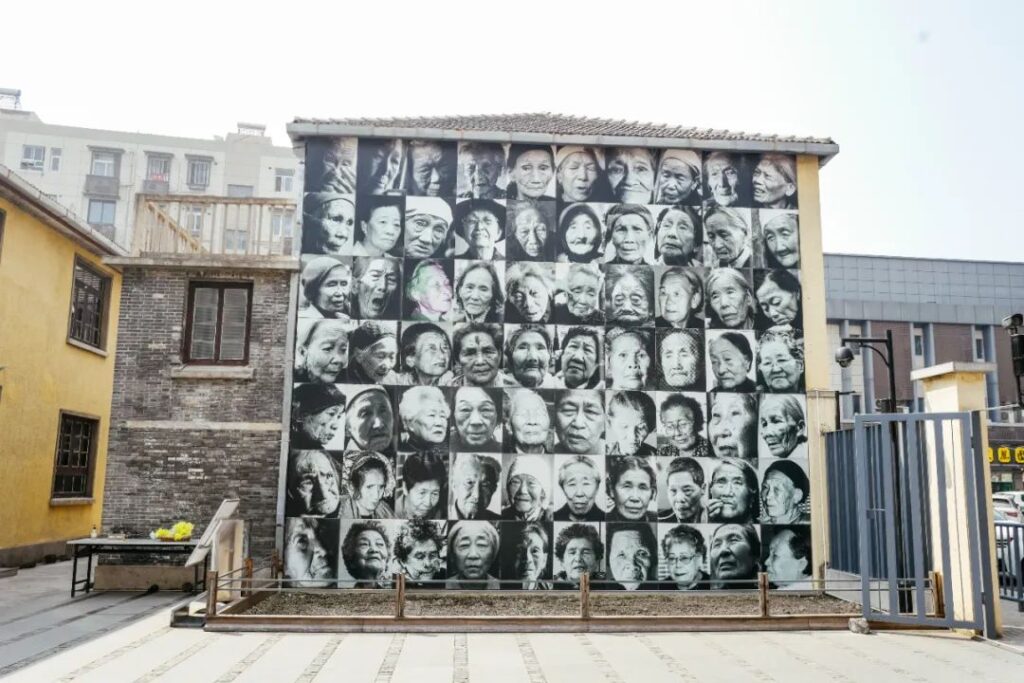
Jiangsu Art Museum
📍: No. 333 Changjiang Road, Xuanwu District, Nanjing
🕐: 9:00-17:00, last entry at 16:30
The exhibitions at the Jiangsu Art Museum change periodically. When I visited, it happened to be an exhibition with the theme of “Yangtze River,” divided into several aspects such as humanities and scenery. Perhaps limited by the theme, most of the works were relatively square, and after seeing many of them, I experienced a bit of aesthetic fatigue…

The Li Jianchen watercolor painting exhibition on the third floor, however, takes the timeline of the artist’s creations as the main thread, spanning from the 1940s to the new century. Walking through it, I felt that the artist had also unintentionally recorded the changes of the times, which was quite interesting.
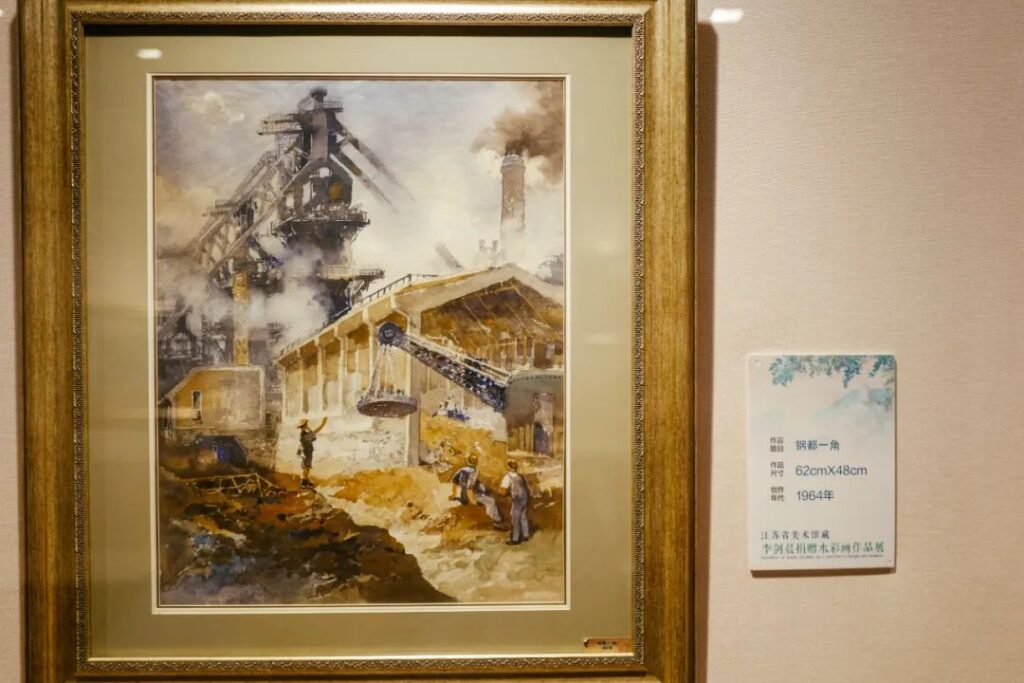
Deji Art Museum
📍: No. 18 Zhongshan Road, Xuanwu District, Nanjing
🕐: 10:00-22:00, last entry at 21:30
If you want to see relatively modern art works, you can go to the Deji Art Museum in Deji Plaza. The museum is located on the top floor of the mall, and the outer layer displays many works by famous artists, such as Yayoi Kusama’s polka-dot pumpkin and Yoshitomo Nara’s little girl… Just walking around the outside is quite worthwhile.

The museum has a free and a paid exhibition space. When I visited, the free exhibition was a showcase of Zhao Zhiping’s works. Various birds, both imaginable and unimaginable, captivated me and were quite interesting. The paid space featured “Three Hundred Years of Flower and Still Life,” a collection of works by Picasso, Pan Yuliang, Zao Wou-Ki, and others.
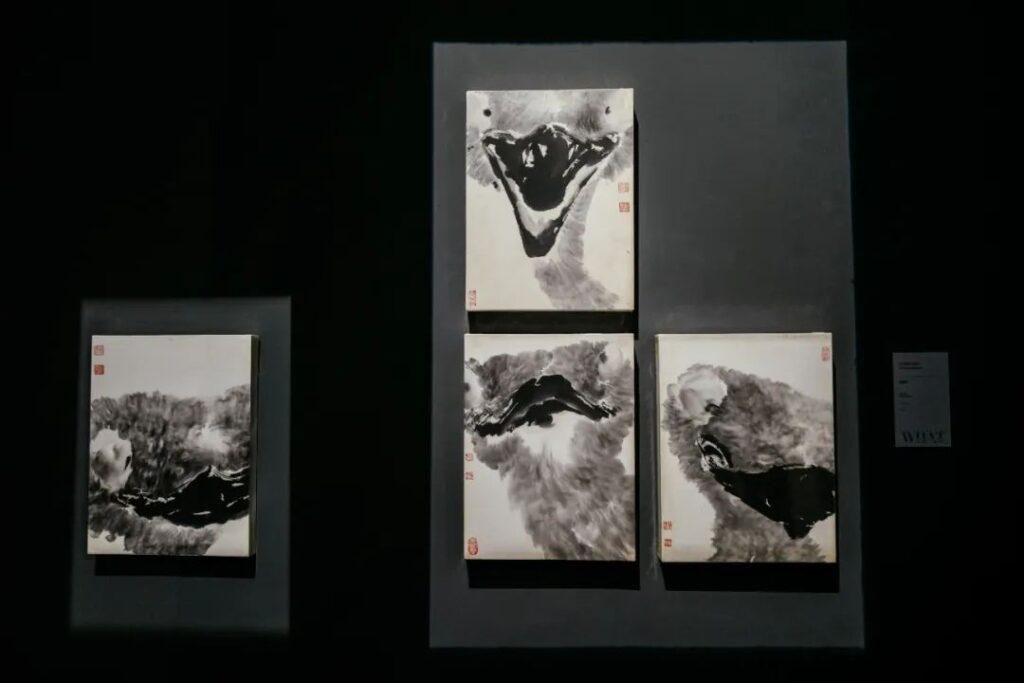
Finally, when visiting Deji Plaza, remember to check out the “5A” attraction here – the restroom.
The image below shows the entrance to the restroom, which fits the artistic atmosphere, doesn’t it?

Eating and Drinking on Changjiang Road
An important part of a citywalk is naturally eating and drinking. Along the way, there are various snack shops where you can choose based on your proximity.
If you specifically want to find food, you can go to Ke Alley or the 1912 Block. The former is a gathering place for various local snacks, while the latter has more restaurants, including the Red House, Nanjing Dapaidang, and even HEYTEA~
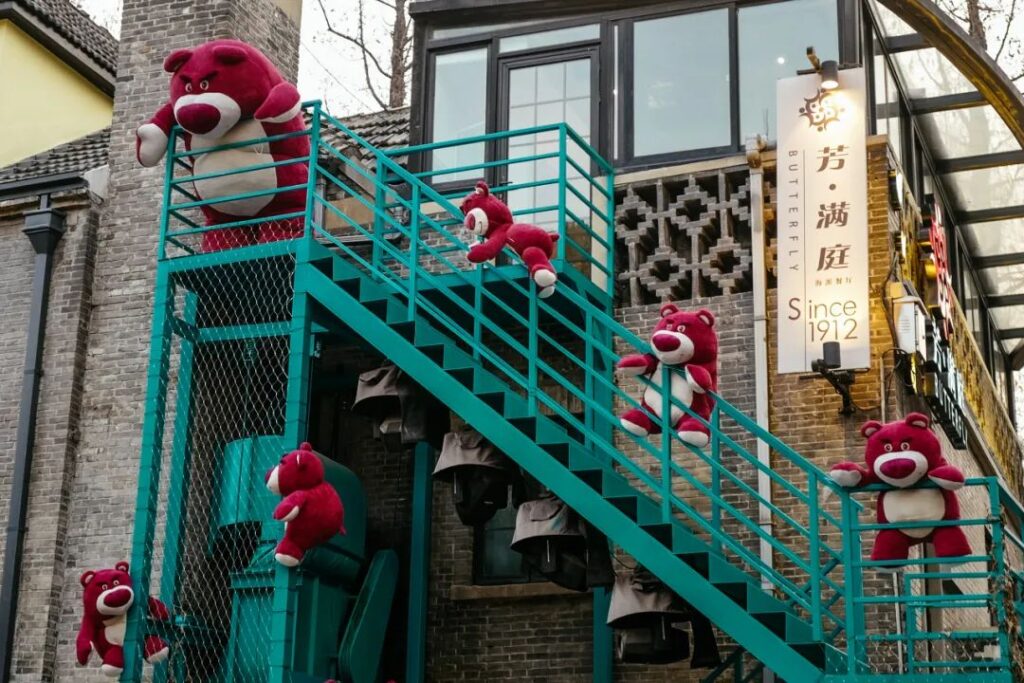
Liu Changxing (Yixian Bridge Store)
📍: No. 506 Zhongshan East Road, Qinhuai District, Nanjing
🕐: 6:00-20:00
This store is right downstairs from the hotel where I stayed, and it almost took care of all my breakfasts in Nanjing.
From the highly recommended red bean rice balls to green rice cakes, soup dumplings, and snacks, you can have something different almost every day.
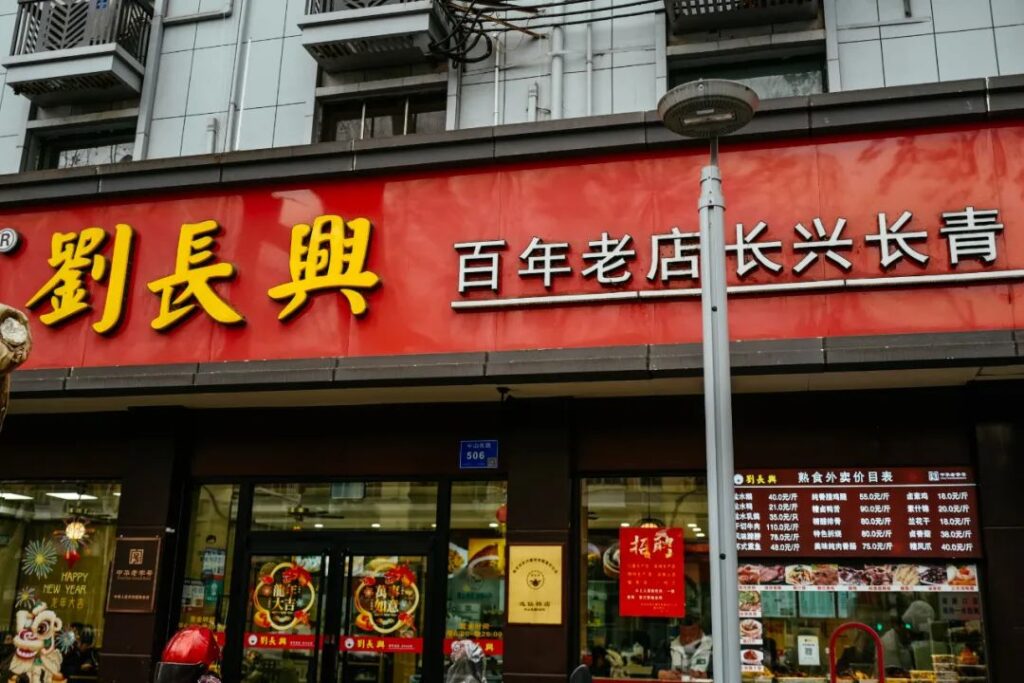
Apart from locals, I also encountered locals bringing friends here to eat, so it can be said that it has a very high level of local recognition.
Having tried almost everything on the menu, I feel that most of the snacks are safe bets without any pitfalls.

But I still want to particularly recommend these shepherd’s purse egg dumplings.
They really taste like spring~ First of all, the dumpling skin and filling have a very soft texture, the kind that feels soft and fluffy when you eat them; secondly, the fresh fragrance of shepherd’s purse and dumplings bursts in your mouth as you bite into them; finally, the skin is thin and the filling is large, making them super satisfying to eat! A sincere recommendation, don’t miss it when passing by!!

Wu’s Ancestral Tea Cake
📍: No. 11 Puhua Alley, Zhongshan East Road Community, Qinhuai District, Nanjing
🕐: 6:30-19:00
Before entering this store, I saw a small cart on the street selling tea cakes, but the owner wasn’t there, and I was curious about what delicious food it was.
It wasn’t until I saw the same steamer in the store that I discovered it was a local snack called tea cake!
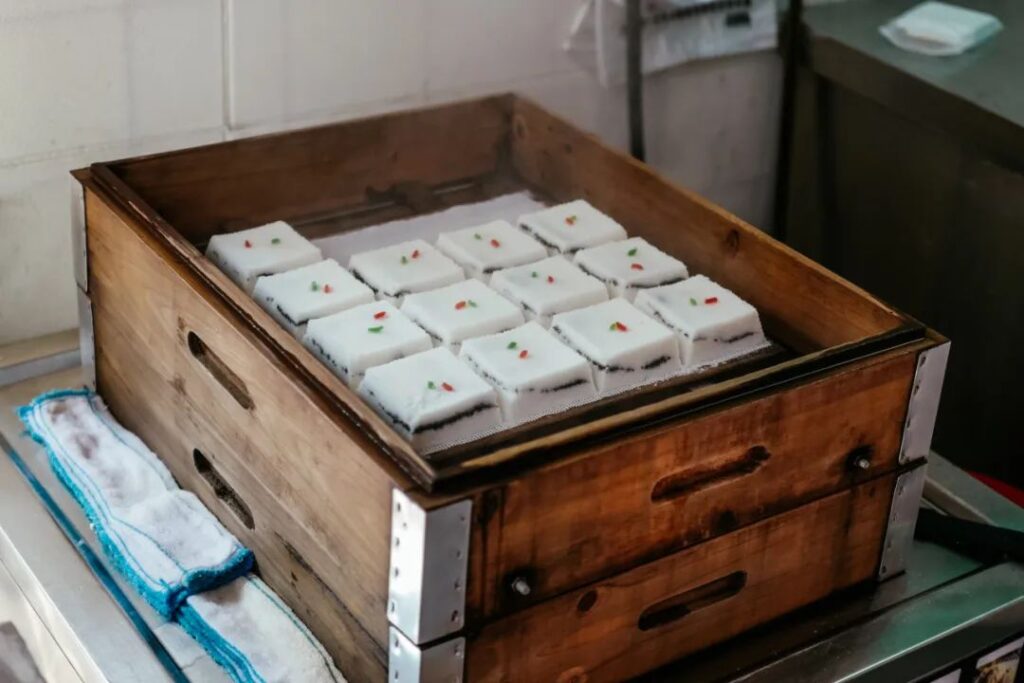
Tea cakes come in original, sesame, and matcha flavors. I chose a sesame one.
The texture is a bit like sand cake, with a slight graininess when you eat it, but overall it’s soft and fluffy with a bit of chewiness. You can taste whole sesame seeds in the filling, which makes it very fragrant and sweet. However, eating too much can be a bit greasy.
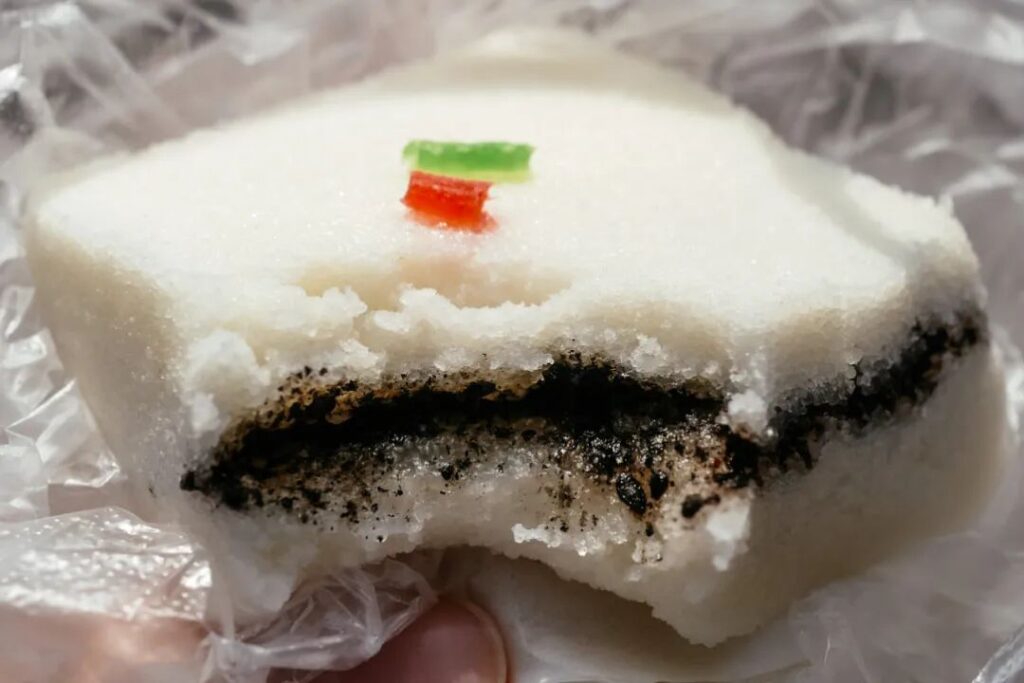
Yunnan Big Pot Soy Milk Shop
📍: No. 60 Santiao Alley, Qinhuai District, Nanjing
🕐: 5:30-13:30
As someone from Yunnan, it was really hard not to go and check it out after seeing this store name.
As soon as you reach the entrance, you can see a large pot filled with steaming soy milk. The soy milk comes in savory and sweet varieties.
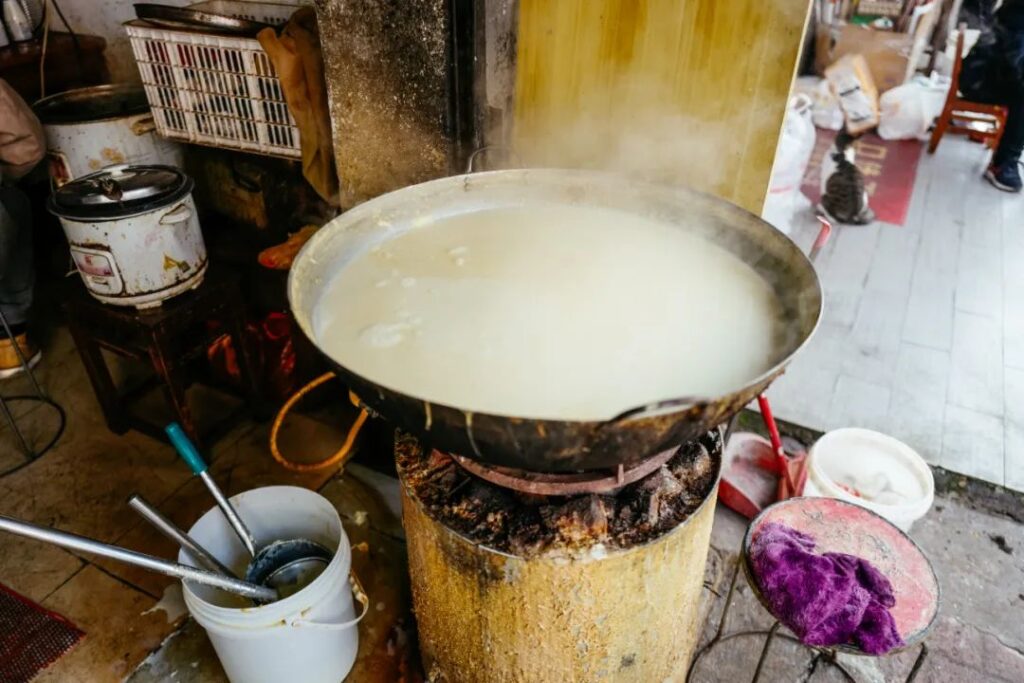
For the savory one, the owner will prepare the seasonings and then you scoop the soy milk yourself. The toppings include crushed fried dough sticks, soy sauce, cilantro, and chili oil, giving it a “spicy soup” feeling when you drink it. The soy milk is very thick, but because the seasoning is quite heavy, you can only taste the fragrance of the soy milk in the aftertaste.
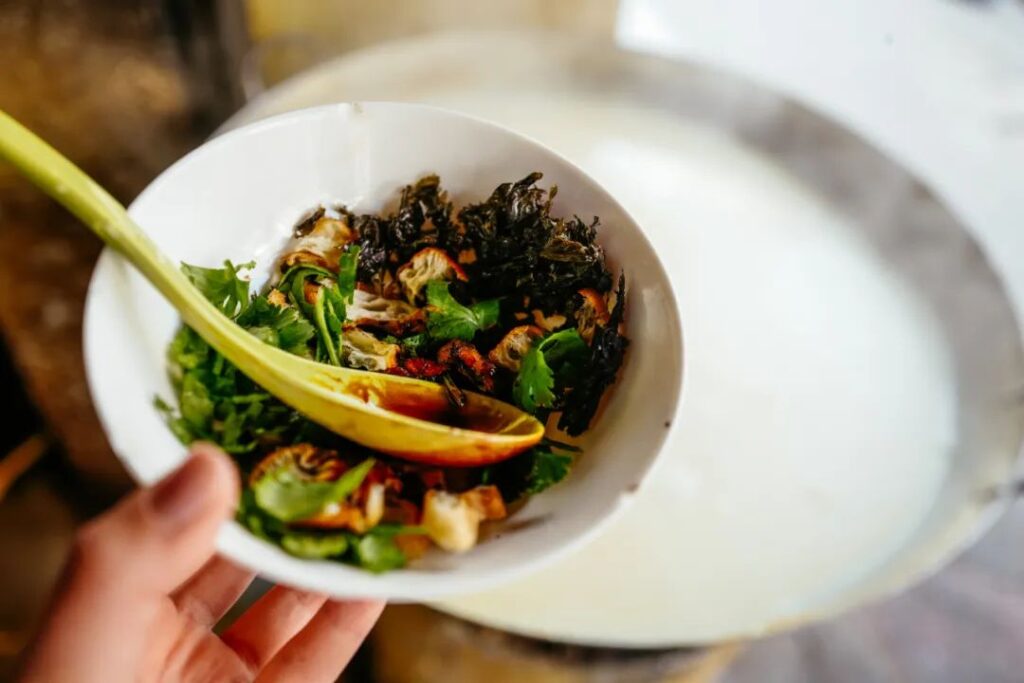
I asked the owner why it’s called “Yunnan Big Pot Soy Milk,” and he said he’s from Dali.
Halfway through drinking, I suddenly remembered that I had ordered the savory one. Back home, there are similar soy milk vendors. But if you don’t eat the savory version, it’s usually soy milk with sticky rice or soy milk with fried dough sticks. The store also has sticky rice and fried dough sticks, so if you like the sweet version, you can give it a try.
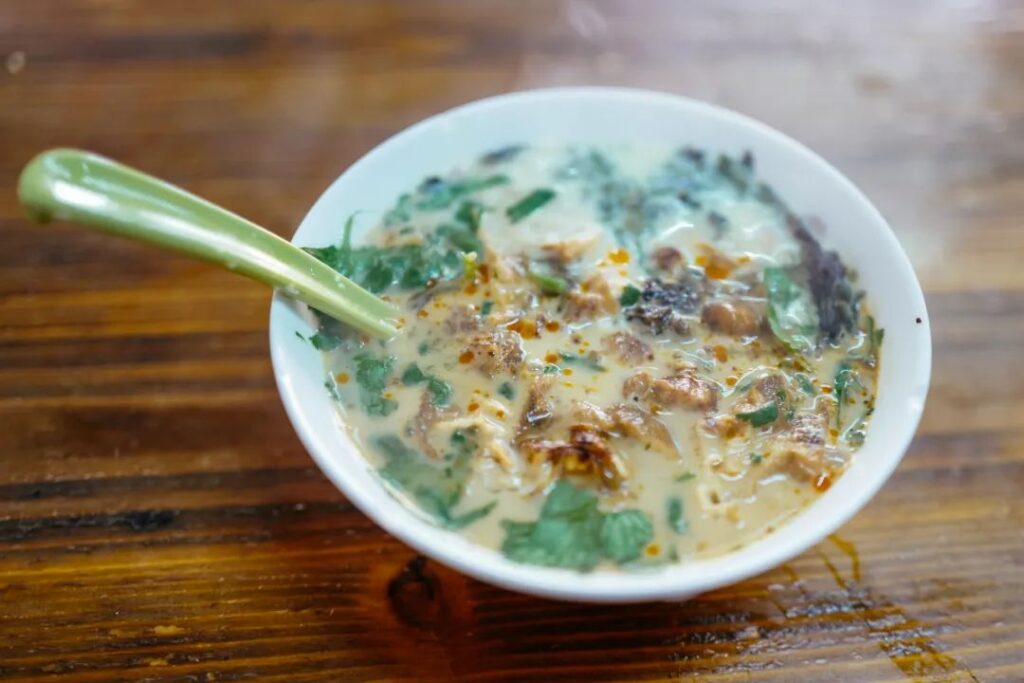
Phoenix Garden Halal Restaurant (Ke Alley Store)
📍: No. 104 Ke Alley, Qinhuai District, Nanjing
🕐: 6:00-19:30
This store is on Ke Alley, right across from the Nanjing Liji Alley Comfort Station Former Site Exhibition Hall.
There are delicious foods all along this street, and quite a few stores have long lines. I couldn’t even squat down to take a photo with fewer people in it.
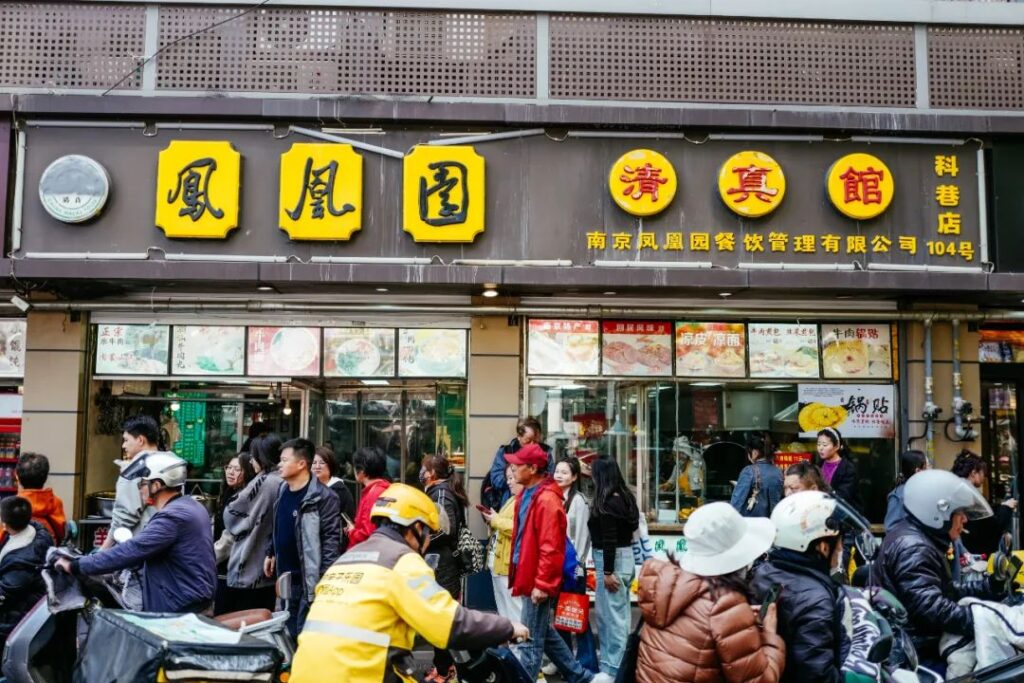
I ordered their signature beef pot stickers, which were very juicy and had a slight sweetness when eaten. The beef filling was very tender, and they also added some chives, making the overall taste quite fragrant. The “soft on top and crispy on the bottom” texture of the pot sticker skin was also perfectly executed.
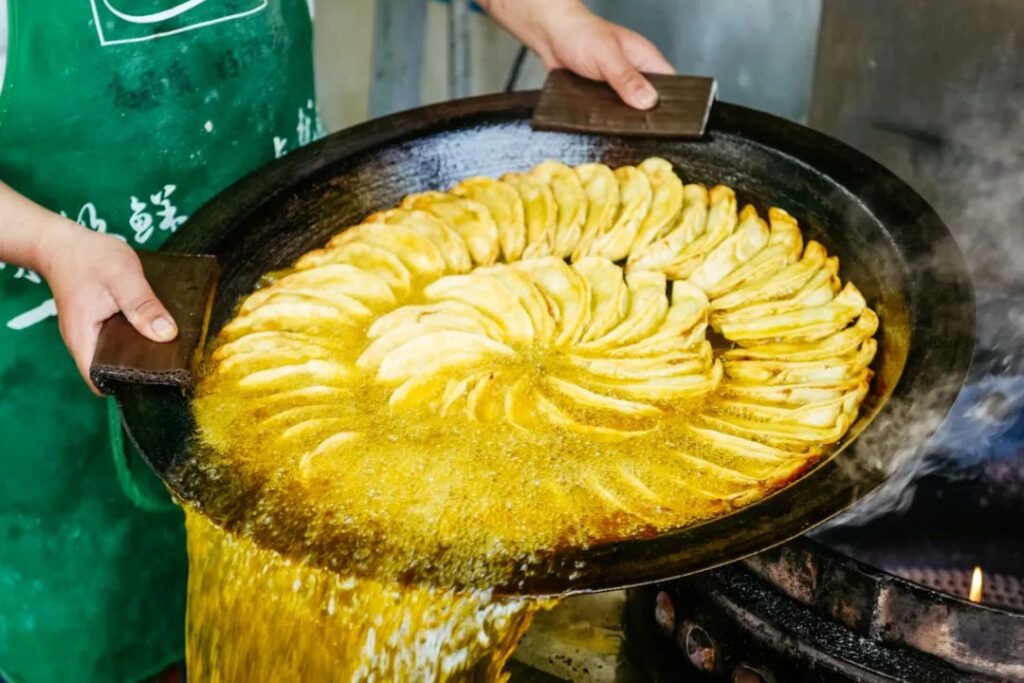
The beef vermicelli soup was also quite tasty, with large chunks of cold-sliced beef inside. The beef was very tender, and the vermicelli had a chewy and elastic texture.
In addition to these, the store also offers fried rice, noodles, and other dishes, but the toppings are mostly related to beef, such as beef tripe, offal, and tongue.
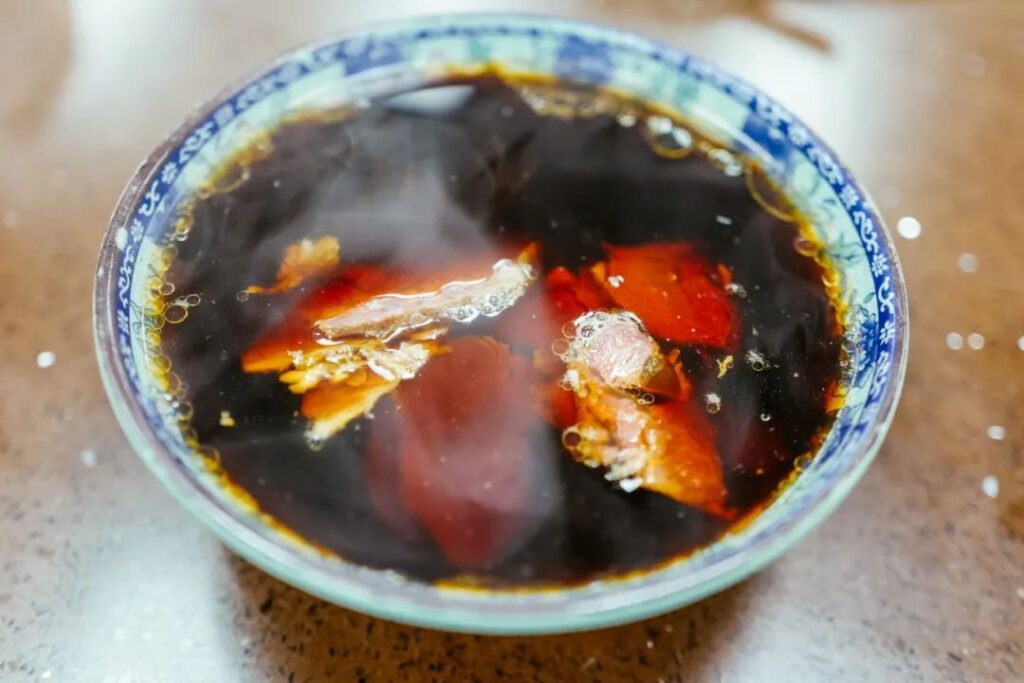
Nanjing St. Regis Luxury Collection Hotel The Traveler’s Library
📍: No. 300 Changjiang Road, Xuanwu District, Nanjing
🕐: 9:00-21:00
This store is next to the Six Dynasties Museum and is the restaurant of the St. Regis Hotel.
The interior decoration is very thoughtful, making it a great place to have afternoon tea, chat with friends, or spend an afternoon alone.
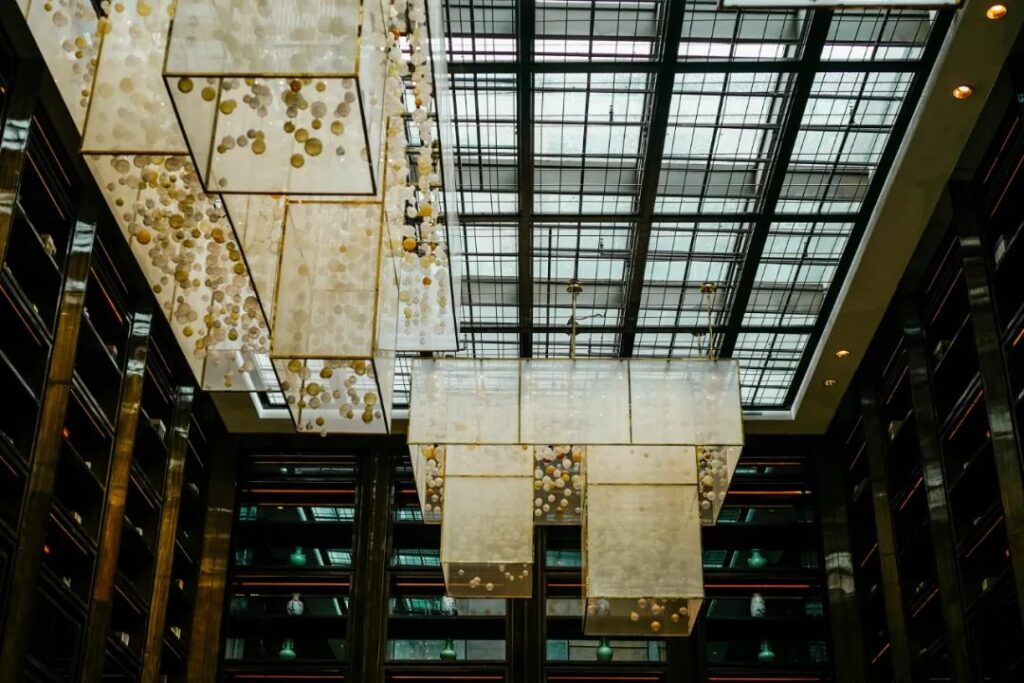
The store also has some books related to Nanjing city, large collections and such, which you can take your time to read slowly.
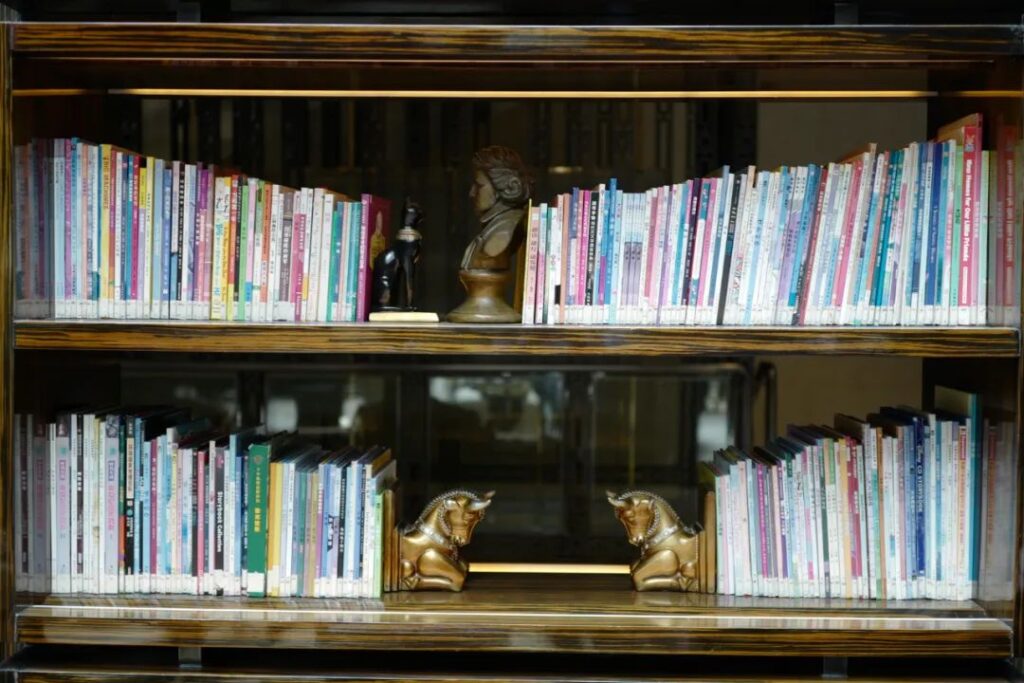
When I went, I had just come out of the Six Dynasties Museum and was hungry from walking around, so I gave up on a leisurely coffee. I directly ordered a shrimp egg fried rice, and the rice grains were distinct, and the shrimp was also large and fresh. Judging by this, the offerings here are still trustworthy.
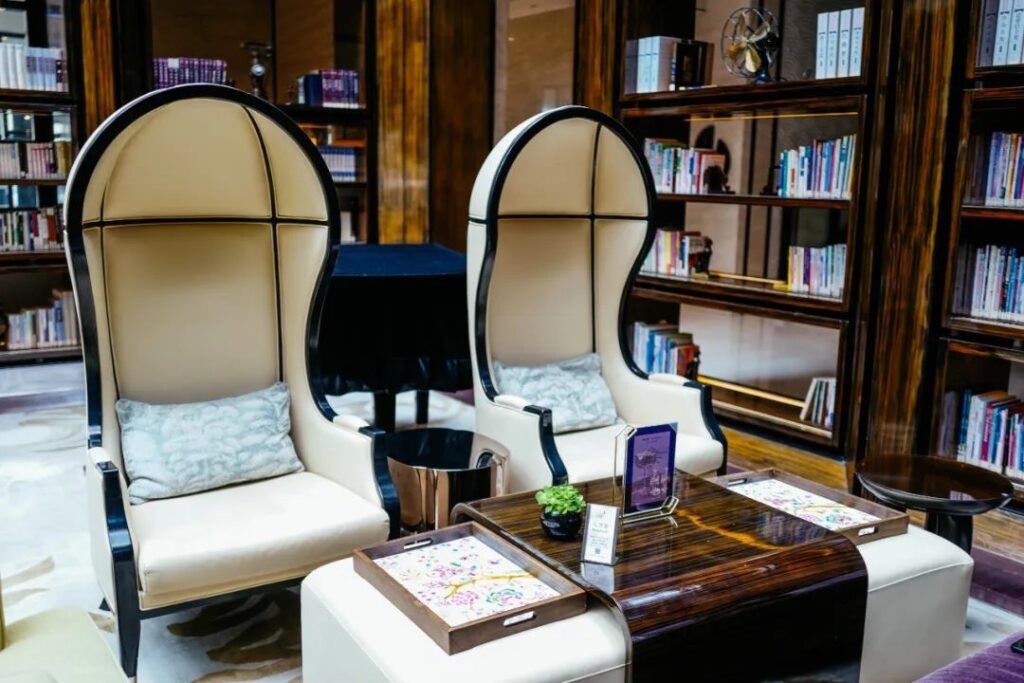
If you have any fun or delicious places to share, feel free to leave a comment and add to the list!
